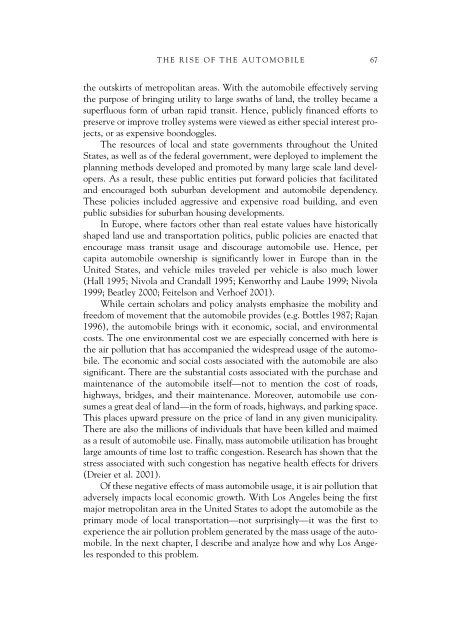GEORGE A. GONZALEZ - fieldi
GEORGE A. GONZALEZ - fieldi
GEORGE A. GONZALEZ - fieldi
You also want an ePaper? Increase the reach of your titles
YUMPU automatically turns print PDFs into web optimized ePapers that Google loves.
THE RISE OF THE AUTOMOBILE 67the outskirts of metropolitan areas. With the automobile effectively servingthe purpose of bringing utility to large swaths of land, the trolley became asuperfluous form of urban rapid transit. Hence, publicly financed efforts topreserve or improve trolley systems were viewed as either special interest projects,or as expensive boondoggles.The resources of local and state governments throughout the UnitedStates, as well as of the federal government, were deployed to implement theplanning methods developed and promoted by many large scale land developers.As a result, these public entities put forward policies that facilitatedand encouraged both suburban development and automobile dependency.These policies included aggressive and expensive road building, and evenpublic subsidies for suburban housing developments.In Europe, where factors other than real estate values have historicallyshaped land use and transportation politics, public policies are enacted thatencourage mass transit usage and discourage automobile use. Hence, percapita automobile ownership is significantly lower in Europe than in theUnited States, and vehicle miles traveled per vehicle is also much lower(Hall 1995; Nivola and Crandall 1995; Kenworthy and Laube 1999; Nivola1999; Beatley 2000; Feitelson and Verhoef 2001).While certain scholars and policy analysts emphasize the mobility andfreedom of movement that the automobile provides (e.g. Bottles 1987; Rajan1996), the automobile brings with it economic, social, and environmentalcosts. The one environmental cost we are especially concerned with here isthe air pollution that has accompanied the widespread usage of the automobile.The economic and social costs associated with the automobile are alsosignificant. There are the substantial costs associated with the purchase andmaintenance of the automobile itself—not to mention the cost of roads,highways, bridges, and their maintenance. Moreover, automobile use consumesa great deal of land—in the form of roads, highways, and parking space.This places upward pressure on the price of land in any given municipality.There are also the millions of individuals that have been killed and maimedas a result of automobile use. Finally, mass automobile utilization has broughtlarge amounts of time lost to traffic congestion. Research has shown that thestress associated with such congestion has negative health effects for drivers(Dreier et al. 2001).Of these negative effects of mass automobile usage, it is air pollution thatadversely impacts local economic growth. With Los Angeles being the firstmajor metropolitan area in the United States to adopt the automobile as theprimary mode of local transportation—not surprisingly—it was the first toexperience the air pollution problem generated by the mass usage of the automobile.In the next chapter, I describe and analyze how and why Los Angelesresponded to this problem.









